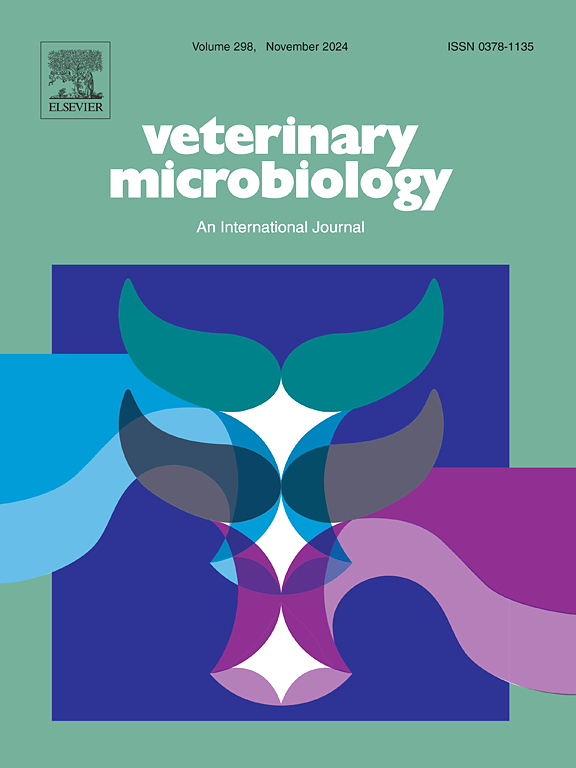Molecular insights into Rickettsiales in blood and ticks of two-humped camels at Gansu Province, China: With an accidental detection of Colpodella sp.
IF 2.4
2区 农林科学
Q3 MICROBIOLOGY
引用次数: 0
Abstract
Emerging infectious diseases caused by various tick-borne microorganisms (TBMs) pose public and animal health concerns, including camels, with no defined global distribution. In this study, 150 blood samples and 288 ticks were collected from symptomatic two-humped camels (Camelus bactrianus) in Gaotai County, Gansu Province, China. Morphologically identified ticks were confirmed using cytochrome oxidase I (COI), and the findings revealed two species, Hyalomma asiaticum and Haemaphysalis longicornis (prevalence: 245/288 [88.19 %] and 34/288 [11.81 %], respectively). The extracted Genomic DNA from blood and ticks was processed by conventional PCR to investigate the existing TBMs based on 16S rRNA, 18S rRNA, and 17-kDa genes. Different TBMs, including Anaplasma bovis, Colpodella sp., Rickettsia rickettsii, and Candidatus Rickettsia jingxinensis, have been documented as single infections at different rates. High single infection rates (198/218; 90.83 % and 117/150; 78.00 %) of A. bovis in Hy. asiaticum and camel blood were recorded, whereas the lowest single infection rate (3/22; 13.64 %) of R. rickettsii was noted in Hae. longicornis. Co-infection with Rickettsia spp. + A. bovis (20/288; 6.94 %), Colpodella sp. + A. bovis (14/288; 4.86 %), Colpodella sp. + Rickettsia spp. (1/288; 0.35 %), and Colpodella sp. + Rickettsia spp. + A. bovis (1/288; 0.35 %) were recorded as concurrent infection. Phylogenetic analysis revealed that the representative TBMs have close similarities and clustered together with their corresponding isolates from China, South Korea, India, the USA, Mexico, Bangladesh, Malawi, Japan, Pakistan, Cyprus, Nigeria, Poland, and Brazil. These findings present a preliminary baseline regarding TBMs infection in camel blood and ticks and provide a framework for further studies on the prevalence and effective control measures for ticks and tick-associated diseases.
甘肃省双峰骆驼血液和蜱中立克次体的分子研究:偶然发现Colpodella sp.。
由各种蜱传微生物(tbm)引起的新出现的传染病对包括骆驼在内的公众和动物健康构成关切,没有明确的全球分布。本研究在甘肃省高台县采集有症状双峰骆驼血样150份,蜱虫288只。利用细胞色素氧化酶ⅰ(COI)对蜱进行形态鉴定,发现亚洲透明瘤和长角血蜱2种(患病率分别为245/288[88.19 %]和34/288[11.81 %])。从血和蜱中提取基因组DNA,采用常规PCR方法对现有的tbm进行16S rRNA、18S rRNA和17kda基因分析。不同的tms,包括牛无原体、Colpodella sp.、立克次体和京新立克次体候选人,已被记录为单次感染,发病率不同。单次感染率高(198/218);90.83 %和117/150;78.00 %),其中单次感染率最低(3/22;13.64 %),在海发现立克次体。longicornis。同时感染立克次体+ A。宝(20/288;6.94 %),Colpodella sp. + A。宝(14/288;4.86 %),Colpodella sp. + 立克次体sp. (1/288;0.35 %),Colpodella sp. + 立克次体sp. + A。宝(1/288;0.35 %)为并发感染。系统发育分析表明,这些代表性的tbm与来自中国、韩国、印度、美国、墨西哥、孟加拉国、马拉维、日本、巴基斯坦、塞浦路斯、尼日利亚、波兰和巴西的相应分离株具有密切的相似性和聚类性。这些发现为骆驼血液和蜱中tms感染提供了初步的基线,并为进一步研究蜱和蜱相关疾病的流行和有效控制措施提供了框架。
本文章由计算机程序翻译,如有差异,请以英文原文为准。
求助全文
约1分钟内获得全文
求助全文
来源期刊

Veterinary microbiology
农林科学-兽医学
CiteScore
5.90
自引率
6.10%
发文量
221
审稿时长
52 days
期刊介绍:
Veterinary Microbiology is concerned with microbial (bacterial, fungal, viral) diseases of domesticated vertebrate animals (livestock, companion animals, fur-bearing animals, game, poultry, fish) that supply food, other useful products or companionship. In addition, Microbial diseases of wild animals living in captivity, or as members of the feral fauna will also be considered if the infections are of interest because of their interrelation with humans (zoonoses) and/or domestic animals. Studies of antimicrobial resistance are also included, provided that the results represent a substantial advance in knowledge. Authors are strongly encouraged to read - prior to submission - the Editorials (''Scope or cope'' and ''Scope or cope II'') published previously in the journal. The Editors reserve the right to suggest submission to another journal for those papers which they feel would be more appropriate for consideration by that journal.
Original research papers of high quality and novelty on aspects of control, host response, molecular biology, pathogenesis, prevention, and treatment of microbial diseases of animals are published. Papers dealing primarily with immunology, epidemiology, molecular biology and antiviral or microbial agents will only be considered if they demonstrate a clear impact on a disease. Papers focusing solely on diagnostic techniques (such as another PCR protocol or ELISA) will not be published - focus should be on a microorganism and not on a particular technique. Papers only reporting microbial sequences, transcriptomics data, or proteomics data will not be considered unless the results represent a substantial advance in knowledge.
Drug trial papers will be considered if they have general application or significance. Papers on the identification of microorganisms will also be considered, but detailed taxonomic studies do not fall within the scope of the journal. Case reports will not be published, unless they have general application or contain novel aspects. Papers of geographically limited interest, which repeat what had been established elsewhere will not be considered. The readership of the journal is global.
 求助内容:
求助内容: 应助结果提醒方式:
应助结果提醒方式:


